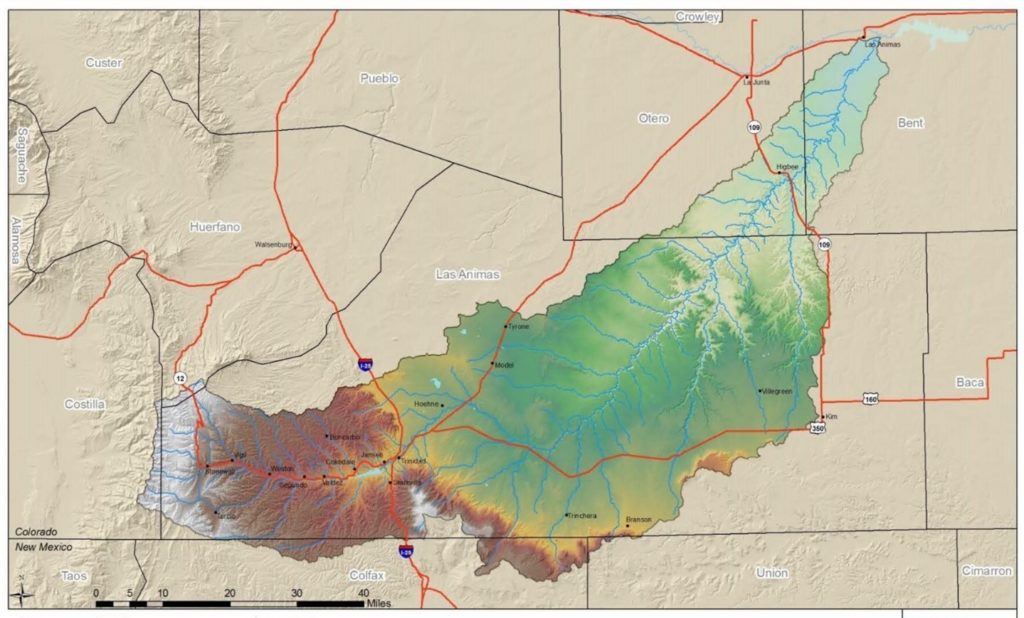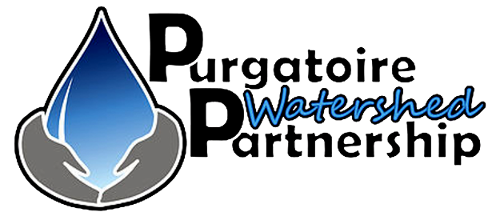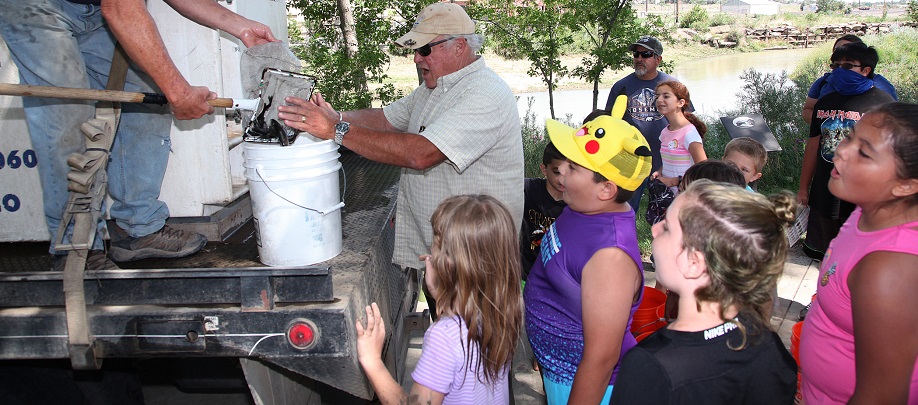The Purgatoire Watershed Partnership (PWP) is a non-profit 501(c)(3) environmental conservation organization based in Trinidad, Colorado serving all community members across the Purgatoire River watershed.
MISSION
Our mission is to restore, protect, and enhance the Purgatoire River Watershed through stakeholder engagement, collaboration, education, and on-the-ground work for the benefit of all.
STAFF
- Executive Director/Watershed Coordinator – Julie Knudson – Julie has worked as a land manager and in a variety of ‘ologist’ roles (restoration ecologist, hydrologist, botanist, soil scientist, weed manager, staff scientist, consultant) across the West on rivers and uplands in Colorado, Montana, and Alaska. She has also worked as an educator both in academia and through coordinating and teaching a host of conferences and workshops and on-the-ground skills training for community members/stakeholders. A trained scientist and land manager, and the daughter of a North Dakota farmer and an Eastern Montana rancher (although Julie was raised in suburban Southern California), she has also experienced some of the divides that can exist between the rural agricultural and urban perspectives, and between academic knowledge and traditional experiential knowledge built through many years of working the land, and is working hard to build bridges and understanding between these perspectives for the long-term benefit of our communities and our watershed. Academic work: Ph.D. Restoration Ecology/Rangeland Ecosystem Science, M.S. Natural Resource Conservation/Soil Science, B.S. Biology & Political Science.
- Board Chairman/President – Tom Verquer – Local Farmer & Rancher, Baca Irrigating Ditch Company Board Member and Secretary, Purgatoire River Water Conservancy District Board Member and Treasurer, Las Animas County Planning Commission Chairman
- Board Vice President – Howard Lackey – Trout Unlimited Local Chapter Purgatoire River Anglers President, Local Business Owner
- Board Treasurer – Glenn Dubis – Stonewall Fire Protection District
- Board Member – Tom Perry – Culebra Range Community Coalition, Purgatoire Valley Foundation, Bar NI Ranch Community Service Fund
- Board Member – Gil Ramirez – City of Trinidad Watershed Manager
- Board Member – Tony Hass – County Commissioner, Local Rancher
- Board Member – Christine Louden – Local Rancher
- Board Member – Amy Harmes – CPW
WHERE WE WORK

We work throughout the Purgatoire River watershed, which is located in southeast Colorado and shares a border with New Mexico. The Purgatoire River is an important tributary of the Arkansas River basin. The Purgatoire River Basin includes 196 miles of river and covers a total area of 2,206,204 acres. It is a hugely diverse watershed with incredible natural resources that we work hard to protect throughout. It is a largely agricultural watershed, with huge expanses of open lands that support a host of farming and ranching activities and plentiful wildlife. The Purgatoire River originates in the headwaters of the Culebra Range of the Sangre de Cristo mountains. The river then winds down through high elevation forested and agricultural lands in the upper watershed until it reaches Trinidad Reservoir. The middle watershed begins at the base of Trinidad Reservoir and is comprised of an important urban wildlife corridor with the river running through a series of small towns on its way to the largest town in the watershed – Trinidad, Colorado (population approximately 9,000). The river winds its way through town, and then enters what we consider to be the lower watershed on the edge of town at the Kit Carson Bypass Bridge across the Purgatoire. The river continues to wind its way across the critical wildlife habitat and agricultural lands of the wide open grassland of the eastern plains. The river then drops down into the beautiful, narrow canyonlands (including the Picketwire Canyonlands and sections of the Comanche National Grasslands) for a stretch before opening back up again until it reaches its confluence with the Arkansas River downstream near the town of Las Animas. Because of its wide open spaces and the many dedicated private and public landowners who work hard to protect it, our watershed is known to support a host of precious flora and fauna, and along with the rich social history of our watershed, is a place that we and our stakeholders truly treasure and are grateful to call home.
WHAT WE DO
The Purgatoire Watershed Partnership works closely and collaboratively with stakeholders across the watershed on a host of projects and educational opportunities for the benefit of our landowners, communities, and the watershed as a whole. The work we do includes:
- Planning & Implementation of On-the-Ground Conservation, Restoration, Recreation, and Improvement Projects
- Education & Skills Training
- Community Engagement & Stewardship Events
- River Health Assessment & Progress Tracking Data Collection
- Engaging and Working Alongside our Community Members/Stakeholders through our Special Programs
OUR PRIORITY FOCUS AREAS
- Agriculture – Supporting healthy, sustainable, and resilient agriculture (e.g., healthy rangelands, efficient and well-functioning infrastructure, drought resilience, sustainable agricultural economy)
- Education – Engaging and supporting community members of all ages through education and skills training to build a better understanding and appreciation of our watershed and stakeholder perspectives, and directly inform on-the-ground practices for the benefit of both participants and our watershed
- Community – Supporting healthy and sustainable communities (e.g., clean water, safe trails, flood protection, water conservation and economic development [e.g., recreational tourism] for long term sustainability)
- Recreation – Supporting responsible recreation development and use (e.g., providing recreation-based education tied to stewardship, providing input and support for local organizations developing and enhancing recreational opportunities, working to protect property rights and wildlife, ensuring maintenance of critical recreation assets while also working to protect critical natural resources)
- Stewardship –
- Encouraging and supporting public lands stewards through community engagement, building deeper connections to the watershed, and education and skills training
- Encouraging and supporting private lands stewards through education, skills training, project funding and other resources
- Through all of these efforts accomplishing important on-the-ground conservation, restoration and recreation enhancement projects on public and private lands for the benefit of all
- Watershed Health – Working towards an ecologically healthy, functional, and resilient watershed
- Science – Utilizing and sharing good applied science for river health assessment, evaluation of progress, and to inform and ensure effective on-the-ground projects
OUR MAIN PROGRAMS
- Ecological Watershed Health Program – Working closely with stakeholders and partners to address ecological needs across the watershed through the planning and implementation of realistic on-the-ground projects aimed at improving the ecological health and functionality of the river and watershed
- Education & Skills Training Program – Engaging stakeholders of all ages through education and skills training for personal empowerment as well as for direct benefit to our river, watershed, and communities
- Farm & Ranch Sustainability Program – Working with local partners to determine gaps & needs and provide additional resources to stakeholders to ensure sustainable and resilient agriculture across the watershed
- Community Health & Sustainability Program – Working to address community health, safety and sustainability concerns tied to our Priority Focus Areas
- Responsible Recreation Development & Use Program – Working to support our partners developing and maintaining recreational opportunities in the watershed, and encourage responsible recreational use through education and providing additional on-the-ground resources
- Conservation Stewardship Program – Engaging, empowering, and supporting our watershed stewards through education, skills training, and connection-building while also providing direct support and resources for accomplishing critical on-the-ground restoration & recreation enhancement projects
- Science, Assessment & Data Collection Program – Working to assess the status of river and watershed health, track the progress of beneficial actions implemented in the watershed, and share and incorporate good applied science into our work
OUR VISION
- An ecologically healthy and well-functioning river and watershed providing significant benefit for community members, visitors, and wildlife
- Healthy, robust and sustainable rural and urban communities across our watershed
- Healthy, sustainable, and resilient agricultural lands, infrastructure, and economy
- All stakeholders with an improved understanding and appreciation of the rich agricultural history of our watershed
- All stakeholders with an improved understanding and appreciation of the benefits of the development of new recreational opportunities and a flourishing arts community in our watershed
- All stakeholders with an improved understanding and appreciation of all of the different water users and ecological components of our river and watershed, and a willingness to work together – despite our differences – to develop better collaborative solutions for the future that benefit all
- All stakeholders with an improved understanding and appreciation of the benefits of good applied science for improving the health and well-being of the watershed and community members
- Responsible development and maintenance of recreational opportunities in the watershed for all, while ensuring protection of our property rights, natural resources, and wildlife
- All recreational users with the appropriate knowledge, tools, and understanding to enjoy our precious recreational opportunities responsibly and to leave things the same or better than they found them
- Strategic management of river flows and water resources to maximize ecological and recreational benefit while ensuring full protection of water rights and agricultural and community sustainability
- All stakeholders with connection to and appreciation of the water and lands that make up our watershed – whether through multi-generational use and/or working of the land, or through new engagement
- All stakeholders actively engaged in the restoration, protection, and/or enhancement of our watershed through providing input, participating in planning and decision-making, engaging in educational activities, applying best practices on their own private lands, and/or getting involved in on-the-ground activities on public lands that improve river and watershed health and sustainability and benefit our communities
OUR PARTNERS
Our work would not be possible without all of the important local and regional partners we work closely with. Partners include individual community members and private and public landowners, local businesses and organizations, local cities and counties, state agencies and organizations, and regional and national organizations. Thank you so much to all of our partners! See our growing list of partners here!
PUBLICATIONS & RESOURCES
- Purgatoire River Assessment Report 2020
- Part 0 – Introduction
- Part 1 – Fish/River Health Assessment
- Part 2 – Hydrology/Hydraulics Modeling & Assessment
- Part 3 – Supplemental – Additional Field Surveys & Assessments – Available Upon Request (large file size)
- Appendix for Part 1 – Available Upon Request (large file size)
- Purgatoire River Watershed Plan 2014
- PWP Strategic Plan 2021-2023
- PEPO Purgatoire River Webisode

